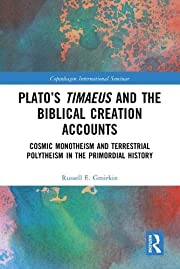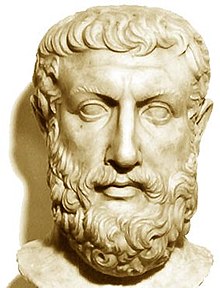
(continuing the series on Russell Gmirkin’s Plato’s Timaeus and the Biblical Creation Accounts) ….
If the authors of Genesis were inspired by Plato’s discourse on the origins of the cosmos in Timaeus how can one explain the obvious contrast between Plato’s lengthy scientific and philosophical reasoning and the simple narrative in Genesis 1:1-2:3?
To answer this question Russell Gmirkin [RG] begins by explaining that there were “seven distinct modes of Greek discourse on cosmogony” and that authors adapted their rhetoric according to the particular audiences each had in view.
1. Scientific Discourse: Natural philosophers most often wrote for their elite, wealthy and educated peers. “Schools” or “universities” were established by prominent thinkers (e.g. Plato’s Academy, Aristotle’s Lyceum) and cosmogonies were written to expound their underlying philosophical reasoning.
2. Revealed Myth: Parmenides of Elea wrote cosmogonies addressed to two different audiences. In Way of Truth he wrote a detailed scientific discourse for his educated peers. In Way of Opinion he wrote a cosmogony in the form of a myth that was being taught by the goddess Justice or Necessity.

In this mode of discourse, the aim was not to achieve knowledge but to induce belief in the theories being presented. Here Parmenides appears to have anticipated Plato, who advocated implanting beliefs in the citizenry as a necessary precursor to achieving true knowledge in a select few . . . . It appears that Parmenides (like Plato) saw a social utility in presenting theories of cosmogony to the general public under divine authority, since he named the appropriate goddess as Necessity or Justice, “who steers the course of all things,” suggesting that a mythical account on cosmogony that recognized a divine steering principle was needed to ensure a pious and just citizenry. It appears that the populace was induced to believe not only that this account of the origins of the universe was divine, but also had the endorsement of the scientific educated elites. The poetic form of the discourse may have been intended to enhance its appeal to the masses. (pp. 66f)
3. Myth as Discourse (Enchantment): Plato taught that in an ideal government philosophers should rule and oversee all aspects of education from infancy to adulthood. The curriculum for the young had to consist of myths that fostered “good” behaviour. These myths needed to be attractive to all ages, especially the young, and hence were to be relayed in songs, poems, theatrical performances and public readings at festivals. Existing myths that told of gods were useful but first had to be censored by the philosopher rulers to remove from them every negative and immoral act of the gods. Nothing bad about the gods was to enter the minds of the citizens. Education was to encompass the whole society, from mothers telling infants nursery rhymes to entertaining performances (singing, reading, acting) for the young and adults.
The aim and intended reception of discourse by myth was to induce belief, and thereby implement societal conformity to theological and ethical norms. Myth, whether in the form of song, story or theatrical performance, was chosen as the medium for inducing belief, due to the pleasant, entertaining, enchanting character of the myth . . . Myth was thus the chosen rhetorical tool to condition the emotions and convey theological and ethical truths on a pre-rational level to intellectually unsophisticated audiences. (p. 68)
Genesis 1 reads as an authoritative story. It was not entirely a myth like other creation myths. It presented a scientific account of the moving power over the primordial chaos bringing about a series of separations that led to day and night, earth and sea, the spontaneous generation of life forms from the ocean, and so forth.
A story format was highly suitable for instilling beliefs about God’s fashioning of the universe for audiences of all ages and was easily understood by school children and even the youngest children, important target audiences under Plato’s system of education. (p. 68)
The second creation account (Genesis 2:4ff) follows up the cosmogony with a mythical narrative about the origins of animals and humans, the reason humans dominate the animals, the introduction of sexual reproduction and clothing, etc. It is a story easily understood by all, from the very young to the old. The beginning of the account may be a subtle reminder of Greek myths:
These are the generations of the heavens and of the earth when they were created . . . — see Gen 2:4 for the Hebrew text
